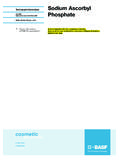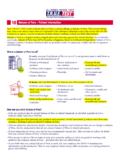Transcription of Vitamin E Acetate - Dr. Baumann's Exclusive …
1 Technical Information Vitamin E Acetate January 2006. Supersedes issue dated November 2005. MEMC 041113e-02/Page 1 of 16. = Registered trademark Active ingredient for the cosmetics industry. of BASF Aktiengesellschaft Hair Care Skin Care Oral Care MEMC 041113e-02 January 2006 Page 2 of 16 Vitamin -E- Acetate Structural formula INCI name Tocopheryl Acetate Synonyms DL-alpha-tocopheryl Acetate , DL-alpha-tocopherol Acetate , all-rac-alpha- tocopherol Acetate , racemic 5,7,8-trimethyltocol Acetate Molecular formula C31H52O3. Molar mass g/mol CAS-No. 7695-91-2. EINECS-No. 231-710-0. Description Light yellow, viscous oil with practically no odor. Solubility Miscible with hydrocarbons, alcohols, fats and oils; insoluble in water Specifications Parameter Requirement Assay Identity Passes test Lead max. 2 mg/kg Appearance conforms Optical rotation to +.
2 Acidity conforms Related substances < Area-%. ( impurity A). Related substances < Area-%. ( impurity B). Related substances < Area-%. ( impurity C). Related substances < Area-%. ( impurity D). Related substances conforms ( , any other impurity max. Area-%). Related substances < Area-%. ( , total impurities). MEMC 041113e-02 January 2006 Page 3 of 16 Vitamin -E- Acetate Monographs The product complies with the current , USP, FCC and Jap. Ph. monographs and with the German regulations for food additives . Application Vitamin E Acetate is an active ingredient for use in cosmetic products for the skin and the hair. As an in-vivo antioxidant, it protects the cells against free radicals and prevents the peroxidation of body fats. It is also an effective moisturizing agent and improves the elasticity and smoothness of the skin.
3 It is particularly suitable for use in sun-protection products and products for daily personal care. Stability and storage Vitamin E Acetate is stable towards heat and oxygen, in contrast to Vitamin E. alcohol (Tocopherol). It is not resistant towards alkalis, as it undergoes saponification, or to strong oxidizing agents. When it is stored in the unopened original container at room temperature the product is stable for at least 36 months. Synergy with Vitamin C: Results of in-vitro study Introduction This study is able to show the synergistic action of Vitamin E and Vitamin C. working together as anti-oxidants in the human skin. Living human keratinocytes (HaCaT cells) were chosen as an in-vitro model. Due to the reduced stability of Tocopherol ( Vitamin E) and Ascorbic Acid ( Vitamin C). in cosmetic formulations pro-drugs are used, typically Vitamin E Acetate and Sodium Ascorbyl Phosphate, respectively.
4 They were therefore used in this in- vitro cell test. The HaCaT-cell system contains the esterases and phosphatases needed to convert the pro-drugs into the active form. Sodium Ascorbyl Phosphate is water soluble and can be used as such in this aqueous cell system. Vitamin E Acetate is insoluble in water and has to be brought into solution with a vehicle. To keep the conditions as simple as possible, ethanol was used as vehicle. Vitamin E Acetate was dissolved in ethanol. A control experiment ensured that the vehicle ( ethanol solution in water) has no disturbing effect. Due to different kinetics of the cleavage of the prodrug into the active form, the optimum reaction time had to be determined empirically in preliminary experiments. It could be shown that a reaction time of 48 hrs. for Sodium Ascorbyl Phosphate and 7 days for Vitamin E Acetate are the ideal conditions.
5 (The compounds are stable in water during this time.) If a combination was tested, Vitamin E Acetate supplementation started 5 days before adding Sodium Ascorbyl Phosphate. Results Human keratinocytes (HaCaT-cells) were supplemented with Vitamin E Acetate (VEA) diss. In ethanol for seven days and/or Sodium Ascorbyl Phosphate (SAP) for 48 hrs. The following concentrations were tested alone and in combination with the other active ingredient. VEA: 3, 10, 30, 100, 300 micromolar SAP: 50, 100, 200, 400 micromolar The anti-oxidant effect was determined in measuring the ability to inhibit hydrogen-peroxide induced oxidation. The cells were incubated with the fluorescence label DCFH. The oxidative stress was induced with 200 micromolar hydrogen peroxide. (These are very harsh conditions.). The capability of VEA and SAP to inhibit oxidation was measured in determing the resulting fluorescence.
6 MEMC 041113e-02 January 2006 Page 4 of 16 Vitamin -E- Acetate Result: 400 mol/L SAP and 300 mol/L VEA. The chart above shows an example with both SAP and VEA at high concentrations. With VEA alone in a concentration of 300 micromolar the inhibition of oxidation is 10%. With SAP alone in a concentration of 400 micromolar the inhibition of oxidation is 14%. If VEA and SAP are used together in the above mentioned concentration, the inhibition of oxidation is over 30%. This is a synergistic effect, because the theoretical addition of the two ingredients results only 24%. The effect is much higher than with the single compounds alone and even higher than the theoretical addition. The following chart shows all the results together. Overview of results First column is SAP alone at different concentrations. The effect is dose dependant, because it increases with the concentration.
7 However, a saturation occurs. From a certain concentration level on, an increase in concentration does not lead to a higher effect. The fact, that 200 mol/L gives the highest effect with 18% while the concentration of 400 mol/L is a bit lower should not be overrated. This will be due to margin of error. The second column is the control experiment. The cells are in an aqueous environment. SAP is soluble in water, so not a problem. Vitamin E Acetate (VEA). is oil-soluble, so it has to be brought into solution with a vehicle. This vehicle is Ethanol, so a simple dispersion. The results shown in this column are the same as in the first column without the vehicle (within margin of error). Therefore the vehicle does not have an effect. The results for VEA in this test-system are trustworthy. MEMC 041113e-02 January 2006 Page 5 of 16 Vitamin -E- Acetate The columns 3-7 show the results with VEA alone and the results of the experiments with the combination of VEA and SAP.
8 The results of VEA alone are always the first column in one group. The concentration increases to the right. The effect is similar to the one of SAP, however lower in value. Increase of concentration leads to a higher effect and again there is a saturation effect. At a certain point an increase of concentration does not lead to a higher effect. Maximum effect is 10% inhibition. All the other columns represent combinations of SAP and VEA. It becomes clearly visible that much higher effects can be obtained if a combination of SAP. and VEA is used compared to the values where only one ingredient is used. Summary of in-vitro study and conclusions The maximum inhibition of hydrogen peroxide-induced oxidation with Sodium Ascorbyl Phosphate (SAP) and Vitamin E Acetate (VEA) alone are 18% and 10 %, respectively. Higher values of inhibition can be obtained only if a combination of SAP and VEA is used.
9 Due to their different solubilities SAP protects the aqueous cytosol part of the system, while VEA is incorporated into the oil-soluble cell-membranes. The synergistic effect of SAP and VEA is therefore due to the fact that only a combination of a watersoluble with a fatsoluble anti-oxidant offers integral protection. MEMC 041113e-02 January 2006 Page 6 of 16 Vitamin -E- Acetate Typical formulations After shave balm No. 07/00040. % Ingredients Supplier INCI name A Pemulen TR-1 (6) Acrylates/C10-30 Alkyl Acrylate Crosspolymer Vitamine E Acetate (1) Tocopheryl Acetate Bisabolol rac. (1) Bisabolol Miglyol 812 (11) Carpylic/Capric Triglyceride Perfume Round (70) Perfume 250 090 . Cremophor CO 40 (1) PEG-40 Hydrogenated Castor Oil B D-Panthenol USP (1) Panthenol Ethanol 96% Alcohol Glycerin 87% (20) Glycerin Tylose H 4000 (28) Hydroxyethyl Cellulose Water dem.
10 Aqua C Sodium Hydroxide (20) Sodium Hydroxide Production: Weigh out the components of phase A and mix them. Stir phase B into phase A whilst homogenizing and continue homogenizing for a while. Neutralize with phase C and homogenize again. Properties: Viscosity: 6000 mPa s Brookfield RVD VII+. pH value: After shave lotion No. 07/00043. % Ingredients Supplier INCI name A Carbopol 1342 (6) Acrylates/C10-30 Alkyl Acrylate Crosspolymer Luvitol EHO (1) Cetearyl Ethylhexanoate Vitamin E Acetate (1) Tocopheryl Acetate Perfume B Ethanol Alcohol D-Panthenol USP (1) Panthenol Glycerin 87% (20) Glycerin Bisabolol rac. (1) Bisabolol Triethanolamine (1) Triethanolamine Care Water dem. Aqua Production: Weigh out the components of phase A and mix them. Fold in phase B and homogenize. Properties: Viscosity: 10000 mPa s Brookfield RVD VII+.









